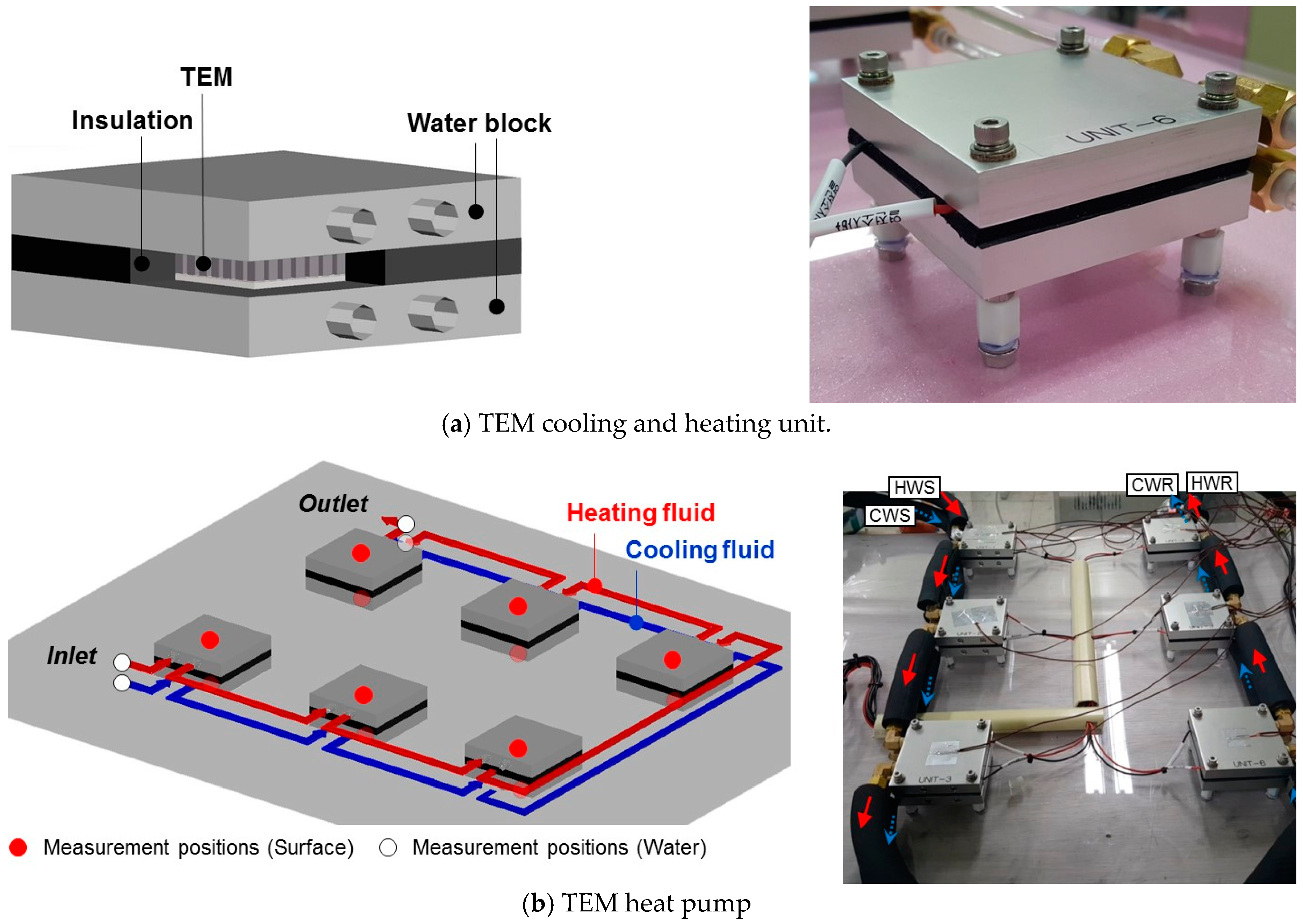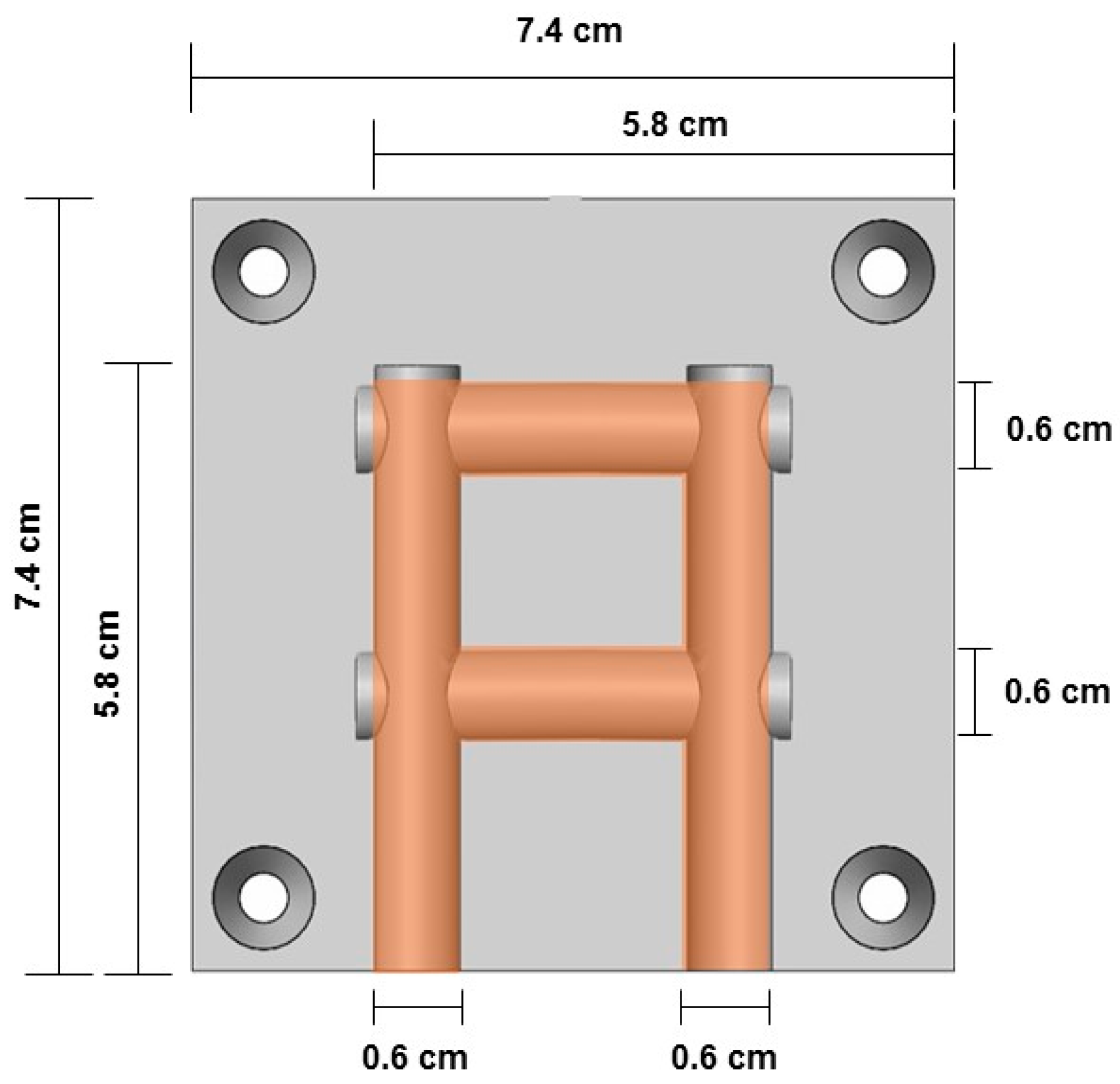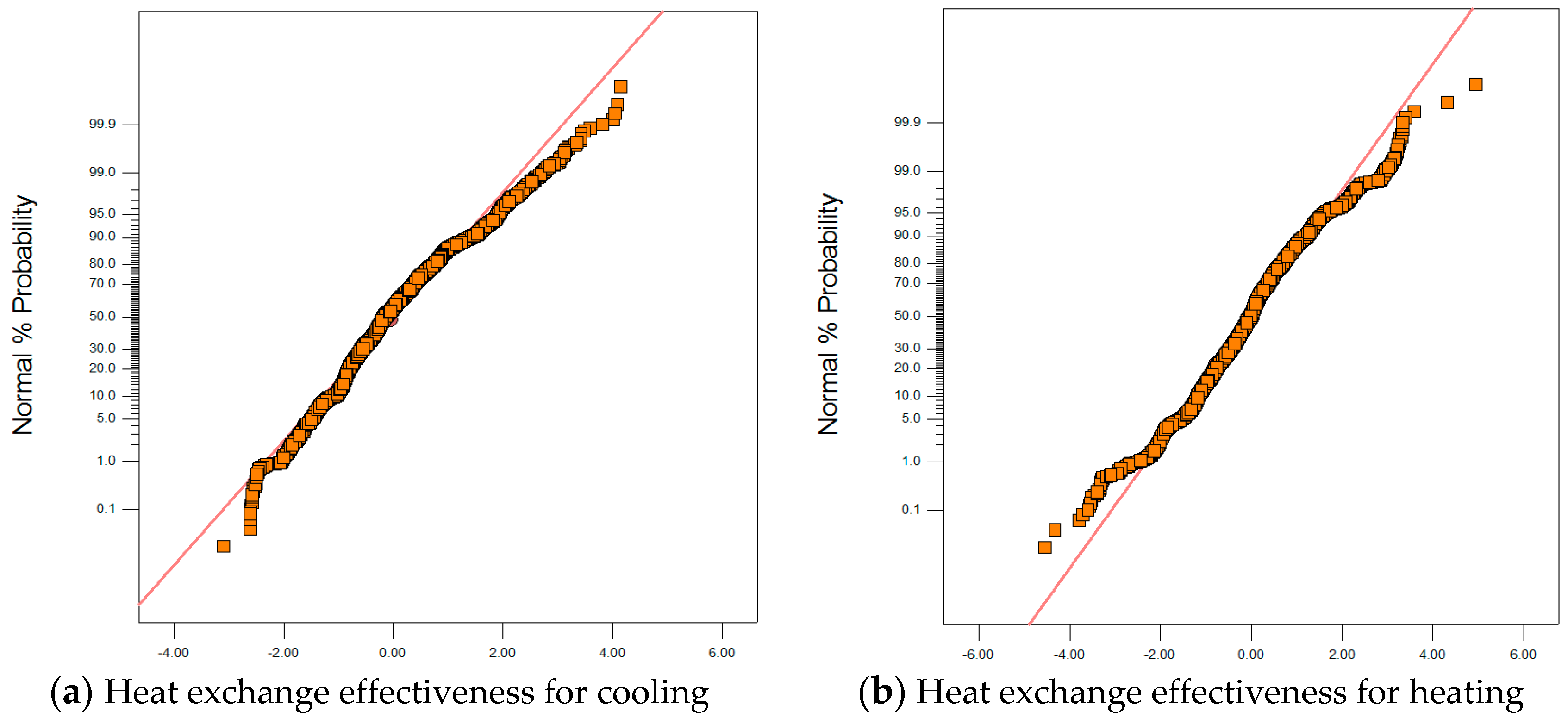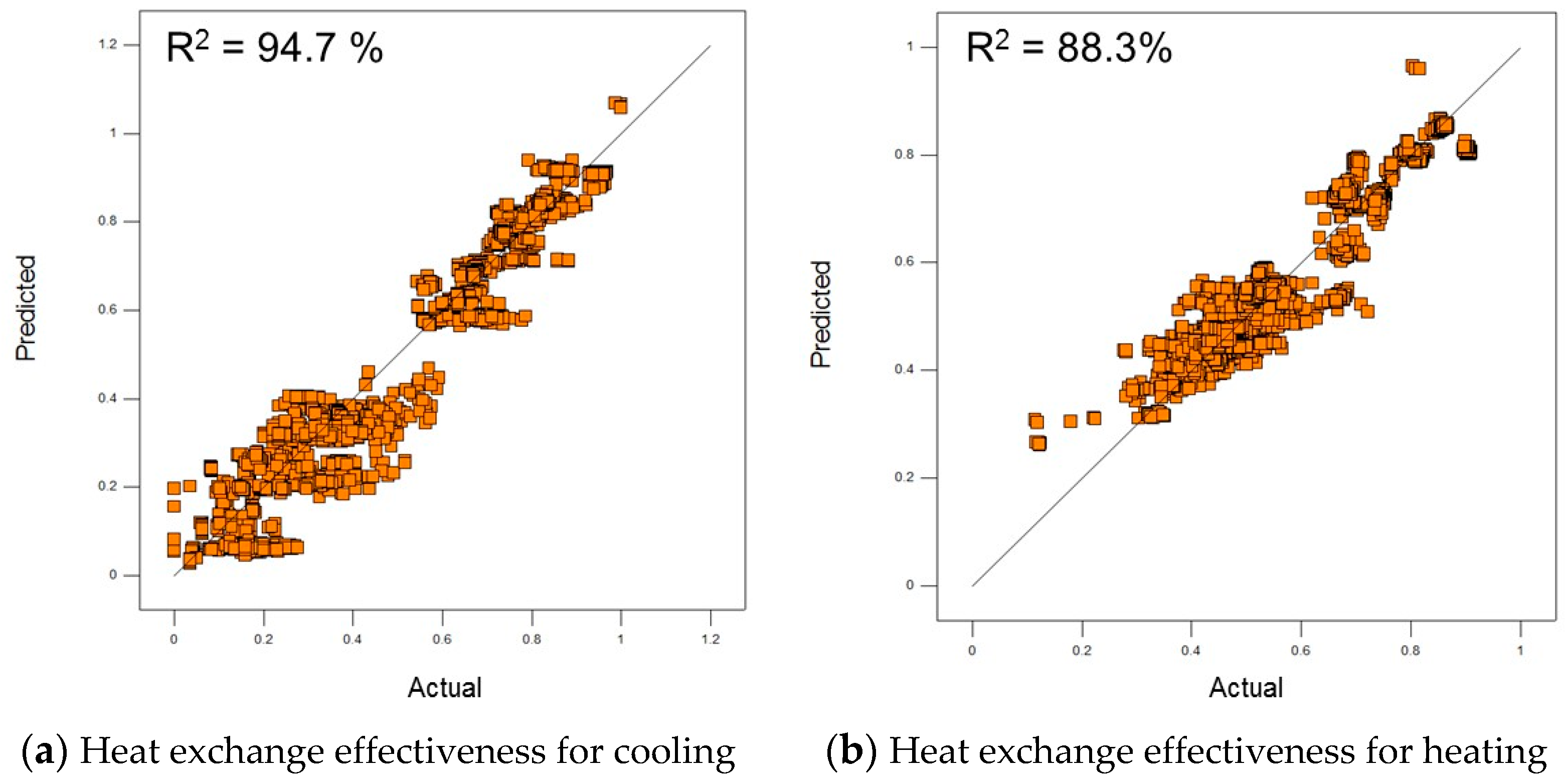Empirical Analysis for the Heat Exchange Effectiveness of a Thermoelectric Liquid Cooling and Heating Unit
Abstract
:1. Introduction
2. System Overview
3. Experiments Design
3.1. Measurement Parameters
3.2. Operation Data
3.3. Uncertainty Analysis
4. Heat Exchange Effectiveness Prediction Model
4.1. Model Parameters
4.2. Model Derivation
4.3. Model Validation
5. Conclusions
Supplementary Materials
Acknowledgments
Author Contributions
Conflicts of Interest
Nomenclature
| A | Area (m2) |
| bx | Fixed error |
| by | Propagation of error |
| cp | Specific heat (kJ/kg·°C) |
| d | Diameter of pipe (m) |
| f | Friction factor |
| h | Convection heat transfer coefficient (W/m2 · K) |
| I | Input current (A) |
| Mass flow rate (kg/s) | |
| M | Mean value |
| N | Number of multiple tests |
| Nu | Nusselt number |
| Pr | Prandtl number |
| py | Random error |
| Re | Reynolds number |
| Sr | Standard deviation of result |
| T | Temperature (°C) |
| Uy | Overall uncertainty |
| V | Velocity of flow (m/s) |
| ZT | Dimensionless figure of merit |
| Abbreviations | |
| ANOVA | Analysis of variance |
| CCD | Center composite design |
| NTU | Number of transfer units |
| RSM | Response surface methodology |
| SMPS | Switched mode power supply |
| TEM | Thermoelectric module |
| Greek Symbls | |
| Model coefficient | |
| Effectiveness | |
| Heat conductivity (W/m·°C) | |
| Viscosity (kg/ms) | |
| Density (kg/m3) | |
| Subscripts | |
| c | Cold |
| h | Hot |
| hx | Heat exchange |
| in | Inlet |
| out | Outlet |
| surf | Surface |
| w | Water |
References
- Goetzler, W.; Guernsey, M.; Young, J.; Fuhrman, J.; Abdelaziz, O. The Future of Air Conditioning for Buildings; Navigant Consulting, Inc.: Burlington, MA, USA, 2016; pp. 1–94. [Google Scholar]
- Al-Nimr, M.A.; Tashtoush, B.M.; Jaradat, A.A. Modeling and simulation of thermoelectric device working as a heat pump and an electric generator under Mediterranean climate. Energy 2015, 90, 1239–1250. [Google Scholar] [CrossRef]
- Ramousse, J.; Sgorlon, D.; Fraisse, G.; Perier-Muzet, M. Analytical optimal design of thermoelectric heat pumps. Appl. Therm. Eng. 2015, 82, 48–56. [Google Scholar] [CrossRef]
- Lee, H. Thermoelectrics: Design and Materials, 1st ed.; John Wiley & Sons, Inc.: Hoboken, NJ, USA, 2017. [Google Scholar]
- Hermes, C.J.L.; Barbosa, J.R., Jr. Thermodynamic comparison of Peltier, Stirling, and vapor compression portable coolers. Appl. Energy 2012, 91, 51–58. [Google Scholar] [CrossRef]
- David, B.; Ramousse, J.; Luo, L. Optimization of thermoelectric heat pumps by operating condition management and heat exchanger design. Energy Convers. Manag. 2012, 60, 125–133. [Google Scholar] [CrossRef]
- Heremans, J.P. Low-dimensional thermoelectricity. Acta Phys. Pol. A 2005, 108, 609–634. [Google Scholar] [CrossRef]
- Tan, G.; Zhao, D. Study of a thermoelectric space cooling system integrated with phase change material. Appl. Therm. Eng. 2015, 86, 187–198. [Google Scholar] [CrossRef]
- Irshad, K.; Habib, K.; Basrawi, F.; Saha, B.B. Study of a thermoelectric air duct system assisted by photovoltaic wall for space cooling in tropical climate. Energy 2017, 119, 504–522. [Google Scholar] [CrossRef]
- Liu, Z.; Zhang, L.; Gong, G. Experimental evaluation of a solar thermoelectric cooled ceiling combined with displacement ventilation system. Energy Convers. Manag. 2014, 87, 559–565. [Google Scholar] [CrossRef]
- Allouhi, A.; Boharb, A.; Ratlamwala, T.; Kousksou, T.; Amine, M.B.; Jamil, A.; Msaad, A.A. Dynamic analysis of a thermoelectric heating system for space heating in a continuous-occupancy office room. Appl. Therm. Eng. 2017, 113, 150–159. [Google Scholar] [CrossRef]
- Wang, C.; Calderon, C.; Wang, Y.D. An experimental study of a thermoelectric heat exchange module for domestic space heating. Energy Build. 2017, 145, 1–21. [Google Scholar] [CrossRef]
- Xie, Y.; Zhang, T.; Liu, X. Performance investigation of a counter-flow heat pump driven liquid desiccant dehumidification system. Energy 2016, 115, 446–457. [Google Scholar] [CrossRef]
- Shin, J.H.; Park, J.Y.; Jo, M.S.; Jeong, J.W. Impact of heat pump-driven liquid desiccant dehumidification on the energy performance of an evaporative cooling-assisted air conditioning system. Energies 2018, 11, 345. [Google Scholar] [CrossRef]
- Yilmazoglu, M.Z. Experimental and numerical investigation of a prototype thermoelectric heating and cooling unit. Energy Build. 2016, 113, 51–60. [Google Scholar] [CrossRef]
- Ramousse, J.; Perier-Muzet, M. Entropy generation minimization in thermoelectric heat pump systems with multi-channel heat exchangers. Int. J. Thermodyn. 2016, 19, 82–90. [Google Scholar] [CrossRef]
- Technical Data Sheet for DWP-385R. Available online: https://www.eleparts.co.kr/EPXGTWHV (accessed on 23 January 2017).
- Technical Data Sheet for HMN6055. Available online: http://www.peltier.co.kr/mobile/sub01/sub01.php (accessed on 23 January 2017).
- Myers, R.H.; Montgomery, D.C.; Anderson-cook, C.M. Building empirical models. In Response Surface Methodology, 3rd ed.; John Wiley & Sons, Inc.: Hoboken, NJ, USA, 2009; pp. 40–146. ISBN 9780470174463. [Google Scholar]
- User’s Manual of MV1000/MV2000 (Yokogawa Electric Corporation). Available online: https://web-material3.yokogawa.com/IMMV1000-01E_020.pdf (accessed on 23 January 2017).
- ASHRAE Guideline 2-2010: Engineering Analysis of Experimental Data; American Society of Heating, Refrigerating and Air-Conditioning Engineers, Inc.: Atlanta, GA, USA, 2010.
- Kim, M.H.; Park, J.Y.; Jeong, J.W. Simplified model for packed-bed tower regenerator in a liquid desiccant system. Appl. Therm. Eng. 2015, 89, 717–726. [Google Scholar] [CrossRef]
- Park, J.Y.; Yoon, D.S.; Lee, S.J.; Jeong, J.W. Empirical model for predicting the dehumidification effectiveness of a liquid desiccant system. Energy Build. 2016, 126, 447–454. [Google Scholar] [CrossRef]
- Cengel, Y.A. Heat exchangers. In Heat and Mass Transfer: A Practical Approach, 3rd ed.; McGraw-Hill Education: New York, NY, USA, 2007; pp. 668–717. [Google Scholar]
- Gnielinski, V. New Equations for heat and mass transfer in turbulent pipe and channel flow. Int. Chem. Eng. 1976, 16, 359–368. [Google Scholar]
- Petukhov, B.S. Heat transfer and friction in turbulent pipe flow with variable physical properties. Adv. Heat Transf. 1970, 6, 503–564. [Google Scholar]
- Jones, R. Response surface methods and other approaches to process optimization. In Design and Analysis of Experiments, 5th ed.; John Wiley & Sons, Inc.: Hoboken, NJ, USA, 1997; pp. 427–510. ISBN 9780471316490. [Google Scholar]
- Jaluria, Y. Search methods. In Design and Optimization of Thermal Systems, 2nd ed.; CRC Press: Boca Raton, FL, USA, 2008; pp. 511–558. ISBN 9780849337536. [Google Scholar]






| Description | Value |
|---|---|
| Dimension | 55 × 55 × 3.7 |
| Imax | 6.0 A |
| Vmax | 28.2 V |
| Qmax | 106 W (Thot = 25 °C) 120 W (Thot = 50 °C) |
| ΔTmax | 68 °C (Thot = 25 °C) 77 °C (Thot = 50 °C) |
| Description | Ranges | ||
|---|---|---|---|
| Min. | Intermediate Values | Max. | |
| I (A) | 1 | 2.5 | 4.2 |
| Th,in (°C) | 45 | 55 | 65 |
| Tc,in (°C) | 15 | 25 | 35 |
| (kg/s) | 0.010 | 0.014 | 0.020 |
| (kg/s) | 0.010 | 0.014 | 0.020 |
| Ahx (m2) | 0.005 | 0.014 | 0.027 |
| Th,in (°C) | Tc,in (°C) | Th,out (°C) | Tc,out (°C) |
| 0.07 | 0.05 | 0.06 | 0.05 |
| Th,surf (°C) | Tc,surf (°C) | (-) | (-) |
| 0.04 | 0.03 | 0.025 | 0.013 |
| Title | Source | Sum of Squares | df | Mean Square | F-Value | p-Value (Prob > F) |
| Heat exchange effectiveness of the water block at the cooling side | Model | 334.66 | 20 | 16.73 | 4121 | 0 |
| A: NTUc | 0.07 | 1 | 0.07 | 16.5 | 0 | |
| B: NTUh | 2.2 | 1 | 2.2 | 540.6 | 0 | |
| C: Tc,in | 1.71 | 1 | 1.71 | 421.3 | 0 | |
| D: Th,in | 0.66 | 1 | 0.66 | 161.7 | 0 | |
| E: Tc,surf | 1.39 | 1 | 1.39 | 342.6 | 0 | |
| F: Th,surf | 1.26 | 1 | 1.26 | 309.9 | 0 | |
| AB | 4.3 | 1 | 4.3 | 1058.8 | 0 | |
| AC | 1.25 | 1 | 1.25 | 308 | 0 | |
| AD | 1.67 | 1 | 1.67 | 411.9 | 0 | |
| AE | 0.35 | 1 | 0.35 | 85.8 | 0 | |
| AF | 1.22 | 1 | 1.22 | 299.8 | 0 | |
| BC | 1.02 | 1 | 1.02 | 250.3 | 0 | |
| BD | 1.4 | 1 | 1.4 | 344.8 | 0 | |
| BE | 0.51 | 1 | 0.51 | 125.1 | 0 | |
| BF | 1.78 | 1 | 1.78 | 439.5 | 0 | |
| CE | 0.13 | 1 | 0.13 | 31 | 0 | |
| CF | 0.28 | 1 | 0.28 | 68 | 0 | |
| DE | 2.4 | 1 | 2.4 | 590.1 | 0 | |
| DF | 0.46 | 1 | 0.46 | 112.4 | 0 | |
| EF | 1.19 | 1 | 1.19 | 293.7 | 0 | |
| Residual | 18.66 | 4595 | 0 | - | - | |
| Cor Total | 353.31 | 4615 | - | - | - | |
| Title | Source | Sum of Squares | df | Mean Square | F-Value | p-Value (Prob > F) |
| Heat exchange effectiveness of the water block at the heating side | Model | 65.43 | 26 | 2.52 | 1333.9 | 0 |
| A: NTUc | 0.03 | 1 | 0.03 | 17.6 | 0 | |
| B: NTUh | 0.03 | 1 | 0.03 | 15.1 | 0 | |
| C: Tc,in | 0.29 | 1 | 0.29 | 152.4 | 0 | |
| D: Th,in | 9.8 | 1 | 9.8 | 5193.9 | 0 | |
| E: Tc,surf | 0.75 | 1 | 0.75 | 398 | 0 | |
| F: Th,surf | 6.46 | 1 | 6.46 | 3423.7 | 0 | |
| AB | 0.08 | 1 | 0.08 | 41.5 | 0 | |
| AC | 0.51 | 1 | 0.51 | 270.6 | 0 | |
| AD | 0.3 | 1 | 0.3 | 157.3 | 0 | |
| AE | 0.54 | 1 | 0.54 | 283.7 | 0 | |
| AF | 0.28 | 1 | 0.28 | 149.6 | 0 | |
| BC | 0.41 | 1 | 0.41 | 217.4 | 0 | |
| BD | 1.16 | 1 | 1.16 | 617.4 | 0 | |
| BE | 0.4 | 1 | 0.4 | 211 | 0 | |
| BF | 0.88 | 1 | 0.88 | 466 | 0 | |
| CD | 0.31 | 1 | 0.31 | 166.4 | 0 | |
| CE | 0.05 | 1 | 0.05 | 26 | 0 | |
| CF | 0.2 | 1 | 0.2 | 108.4 | 0 | |
| DE | 0.24 | 1 | 0.24 | 128.8 | 0 | |
| DF | 0.2 | 1 | 0.2 | 107.1 | 0 | |
| A2 | 0.16 | 1 | 0.16 | 83.3 | 0 | |
| B2 | 0.04 | 1 | 0.04 | 19 | 0 | |
| C2 | 0.11 | 1 | 0.11 | 58.6 | 0 | |
| E2 | 0.09 | 1 | 0.09 | 46.8 | 0 | |
| F2 | 0.02 | 1 | 0.02 | 11.9 | 0 | |
| Residual | 8.66 | 4589 | 0 | - | - | |
| Cor Total | 74.09 | 4615 | - | - | - |
| Title | ||||||
| Heat exchange effectiveness of the water block at the cooling side | 1.32386 | 2.13151 | −0.21917 | −0.07775 | −0.10210 | 0.14882 |
| 0.02493 | 1.54234 | −0.20965 | −0.15685 | 0.14243 | 0.11509 | |
| 0.15134 | 0.08917 | −0.12650 | −0.09076 | −0.00059 | 0.00174 | |
| 0.00252 | 0.00064 | −0.00428 | ||||
| Title | ||||||
| Heat exchange effectiveness of the water block at the heating side | 1.36779 | −2.02188 | 1.02213 | 0.12883 | −0.02411 | −0.10955 |
| −0.02268 | 2.42325 | 0.34868 | 0.08469 | −0.31819 | −0.08379 | |
| −0.19027 | −0.10530 | 0.17723 | 0.10283 | −0.00661 | 0.00933 | |
| 0.00523 | 0.00594 | 0.00117 | −0.00459 | −1.76450 | −0.98080 | |
| −0.00640 | −0.00313 | −0.00068 |
| Design Parameter | NTUc | NTUh | Tc,in | Th,in | Tc,surf | Th,surf |
|---|---|---|---|---|---|---|
| Low | 0.09 | 0.19 | 15.4 | 42.1 | 12.3 | 44.9 |
| High | 0.91 | 1.50 | 37.6 | 65.4 | 34.0 | 76.6 |
| Description | Ranges | |
|---|---|---|
| Min. | Max. | |
| I (A) | 1.8 | 3.4 |
| Th,in (°C) | 23 | 30 |
| Tc,in (°C) | 52 | 60 |
| (kg/s) | 0.014 | 0.017 |
| (kg/s) | 0.014 | 0.017 |
© 2018 by the authors. Licensee MDPI, Basel, Switzerland. This article is an open access article distributed under the terms and conditions of the Creative Commons Attribution (CC BY) license (http://creativecommons.org/licenses/by/4.0/).
Share and Cite
Lim, H.; Cheon, S.-Y.; Jeong, J.-W. Empirical Analysis for the Heat Exchange Effectiveness of a Thermoelectric Liquid Cooling and Heating Unit. Energies 2018, 11, 580. https://doi.org/10.3390/en11030580
Lim H, Cheon S-Y, Jeong J-W. Empirical Analysis for the Heat Exchange Effectiveness of a Thermoelectric Liquid Cooling and Heating Unit. Energies. 2018; 11(3):580. https://doi.org/10.3390/en11030580
Chicago/Turabian StyleLim, Hansol, Seong-Yong Cheon, and Jae-Weon Jeong. 2018. "Empirical Analysis for the Heat Exchange Effectiveness of a Thermoelectric Liquid Cooling and Heating Unit" Energies 11, no. 3: 580. https://doi.org/10.3390/en11030580
APA StyleLim, H., Cheon, S.-Y., & Jeong, J.-W. (2018). Empirical Analysis for the Heat Exchange Effectiveness of a Thermoelectric Liquid Cooling and Heating Unit. Energies, 11(3), 580. https://doi.org/10.3390/en11030580






